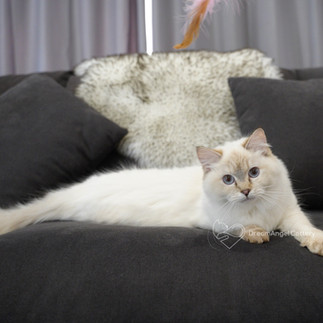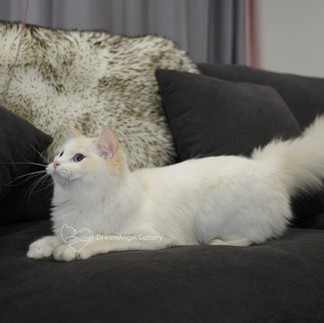Welcome to our latest blog post where we dive into the enchanting world of Ragdoll cats, exploring the genetics behind some of their most captivating colours and patterns: tabby (lynx), mink, red/cream, and tortoiseshell. Understanding these genetic influences not only adds depth to our appreciation of their beauty but also helps breeders and enthusiasts alike.
The Mystical Tabby (Lynx) Ragdolls
The tabby, or lynx, pattern in Ragdolls is marked by its distinct 'M' shaped mark on the forehead, accompanied by stripes, whorls, and spots across the coat. This pattern is the result of the agouti gene (symbolized as A) which determines whether a cat will have a solid coat colour or a pattern. The presence of the tabby gene (Ta) modifies this pattern, adding the characteristic lynx appearance.
Pictures below show a seal bicolour ragdoll with (left) and without (right) tabby.
Pictures below show a blue bicolour ragdoll with (left) and without (right) tabby.
The Enigmatic Mink Ragdolls
The concept of Mink Ragdolls, cherished by some breeders, is rooted in the enchanting beginnings of the Ragdoll breed in the 1960s, attributed to Ann Baker and a non-pedigree cat named Josephine. It's believed that Josephine, through her lineage with a black tom named Blackie, gave rise to the genetic markers that define Mink and, possibly, Sepia Ragdolls. According to this belief, the Mink trait, signified by the presence of one Cb gene, distinguishes itself by offering a body color more vivid than the points, yet not as intense as the Sepia, which carries two copies of the Cb gene. This nuanced genetic inheritance is thought to allow Mink Ragdolls to display the full array of Ragdoll colors and patterns from birth, with their plush fur and eye color transitioning from blue to an aqua hue as they mature, embodying a unique charm. Such views, though specific to certain breeding circles, underscore the complexity and depth of Ragdoll genetics, weaving a rich tapestry of history, belief, and the beauty inherent in genetic diversity.
Pictures below show a seal bicolour ragdoll with (left) and without (right) .
Pictures below show a seal/red tortie mitted ragdoll with mink (left) and a seal/red tortie mitted tabby ragdoll without (right) mink
The Radiant Red/Cream Ragdolls
The red and cream colours in Ragdolls are the result of the O gene, which controls the orange colour spectrum in felines. The presence of this gene (O) results in red or orange hues, while its absence (o) leads to black or brown. When combined with the dilution gene (d; more inform here), these colours soften to cream. This genetic trait is sex-linked, making it more common in males than females. To have a female red/cream Ragdoll, the O gene needs to be present in both parents.
Pictures below show a male red (left) and cream (right) mitted ragdoll.
The Unique Tortoiseshell Ragdolls
Tortoiseshell Ragdolls showcase a captivating mix of colours, typically seal/chocolate and red or their diluted versions, blue/lilac and cream. This pattern is not a result of a single gene but a combination of the O sex-linked gene and random X-chromosome inactivation in females, leading to the mosaic of colours. Each tortoiseshell cat is truly unique, as this pattern cannot be replicated exactly.
The pictures below show a female chocolate/red tortie tabby point Ragdoll (left), a chocolate/red tortie tabby bicolor Ragdoll (middle), and a seal/red tortie tabby mitted Ragdoll (right).
Genetics: The Blueprint of Beauty
Each of these Ragdoll colours and patterns is a testament to the fascinating world of genetics. While breeders might aim for specific traits, nature often surprises us with its creativity. Understanding the genetic underpinnings helps breeders in planning and predicting the outcomes of their breeding programmes, but it also enriches the experience of every Ragdoll enthusiast.
We hope this deep dive into the genetics of Ragdoll colours and patterns has been as enlightening for you as it has been fascinating for us to compile. Don't forget to share your thoughts and your own Ragdoll photos in our page!
#DreamAngelCattery #RagdollCatsNZ #NewZealandRagdolls #ChristchurchCatBreeders #CanterburyCatLovers #RagdollGenetics #MinkRagdolls #TabbyRagdolls #TortieRagdolls #RedCreamRagdolls #SouthlandCattery #RagdollBreederNZ #RagdollPatterns #EnchantingRagdolls #RagdollCatCommunity #RagdollColours #NZCatBreeders #RagdollLoveNZ #CatsofCanterbury #RagdollBeauty





























Comentarios